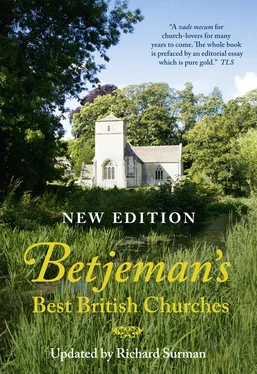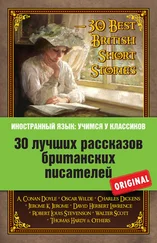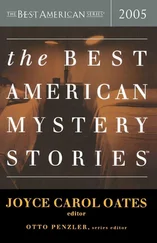2 This church was destroyed by the Southwark Diocese after war damage.
But we can see other churches influenced by the Neo-Perpendicular movement, and many of these are very fine buildings, no more imitations of medieval than were the works of the older Victorians. They are, however, less Victorian than the daring experiments of the ’fifties and ’sixties, and they seem, like the small houses designed by Norman Shaw, to come into our time or at any rate into the 1920s. Because they are near us, we do not appreciate their originality. In our desire to see a new style emerge from new materials, we notice only that the mouldings and fittings are copies of medieval Gothic. We do not realize that the proportions, plan and liturgical arrangement are nothing like our old churches.
See in your mind’s eye a church built in the neo-Perpendicular style by G. G. Scott Junior, Bodley, W. H. Bidlake of Birmingham, Edgar Wood, Sir Ninian Comper, W. D. Caroe, Sir Charles Nicholson, Temple Moore, J. D. Sedding, Edmund Sedding, Charles Spooner, E. P. Warren, Walter Tapper, Niven and Wigglesworth, Paley & Austin, to name a few of these later Victorian architects. If you cannot see it, I will try to re-create such a church, and you will remember it in some newish suburb of a provincial town where you stayed with an aunt, or on a holiday in the outskirts of a south-coast watering place, and you can read of it in Compton Mackenzie’s Sinister Street. ‘Ting-ting’ the single bell calls to Sung Eucharist, because the tower, designed for a full peal of bells, was never completed. Rather gaunt without it, the church rises above the privet and forsythia and prunus of its little garden, for there is no churchyard to these churches; we have reached the era of municipal cemeteries, and it is in their marble acres that the dead of this new parish are to be found. Inside the church, the tall nave is filled with chairs, and the narrow aisles are not used on a Sunday, as they give a view only of side altars where the weekday Celebrations and the very early Sunday masses are said. The floor is of oak blocks, the walls are cream and clean, the woodwork of the thick Devonshire style chancel screen, carved by Harry Hems of Exeter, is unstained. In more recent times a coloured statue of Our Lady under a gilded canopy is seen against one of the eastern-most pillars of the nave. Through the screen we glimpse a huge reredos painted green and red and gold, with folding doors. The high altar has a purple frontal, because just now it is Lent. The floor of the sanctuary is paved with black-and-white marble. Riddel posts with gilt angels on them – the famous ‘English altar’ introduced by Sir Ninian Comper in the ’eighties – hold curtains round the north, south and east of the side altars. The windows are filled with greenish glass in which are patches of dark blue, red and gold. These are the work of Kempe, and they allow more light into the church than earlier Victorian windows. The chief beauty of the church is its proportion. These architects favoured two kinds of proportion when they were building in the Gothic style – almost all of them designed Byzantine and classic churches as well – and they were either height and narrowness, or breadth and length. Their churches either soar or spread.
The Sung Eucharist is probably from the Prayer Book and with a crowd of acolytes at the altar. Blue incense rises to the golden reredos and the green Kempe window. The English Hymnal is used, and plain-song or more probably, Eyre in E [flat] or Tours in C. Candlelights twinkle in the mist. The purple Lenten chasuble of the priest is worn over amice, alb, stole and maniple, and there is discussion of these things after the service and before among servers and the initiated. We are in a world which feels itself in touch with the middle ages and with today. This is English Catholicism. There is much talk of Percy Dearmer, correct furnishings and vestments, the Prayer Book and how far one is justified in departing from it. After church the acolytes in their Sunday suits hang round the porch, and the young curates too, and there is a good deal of backslapping and chaff. For months the Mothers’ Union and women’s guilds of the church have been working on banners and a frontal to be ready for Easter. From these suburban parishes much of the Church life of modern England has sprung. They have trained their people in faith and the liturgy, they have produced many of the overseas missionaries and parish priests of today.
We are in modern times, out of the older and rich suburbs with their garden city atmosphere of guild craftsman and Sarum Use, and into the big building estates. The large areas of semi-detached houses, built by private speculators or councils, have been eating up our agricultural land since 1920. They have been brought about by the change in transport from steam to motor-bus and electric train. People are moving out of the crowded early Victorian industrial lanes and terraces, into little houses of their own, each with its little patch of garden at the back and front, each isolated from its neighbour by social convention, in districts where miles of pavement enlivened by the squeak of perambulators lead to a far-off bus route and parade of chain stores, and a distant vita-glass school, used as a Community Centre in the evenings. To these places, often lonely for all the people in them, is the new mission Church.
Just as there is today no definite modern style in England, except in what is impermanent – exhibition buildings, prefabs, holiday camps and the like, so there is no definite modern church style. In the period between the two wars church architects were too often concerned with style, and they built places of worship which vied with the local Odeon or with by-pass modern factories in trying to be ‘contemporary’. They now look dated, and will, I fear, never look beautiful. But the purpose of the church remains the same as it was at the beginning of this book, to be a place where the Faith is taught and the Sacraments are administered.

TUDELY: ALL SAINTS – one of the windows created by Marc Chagall to commemorate Sarah Venetia d’Avidgor Goldsmid, who drowned in the 1960s
© Richard Surman
Конец ознакомительного фрагмента.
Текст предоставлен ООО «ЛитРес».
Прочитайте эту книгу целиком, купив полную легальную версию на ЛитРес.
Безопасно оплатить книгу можно банковской картой Visa, MasterCard, Maestro, со счета мобильного телефона, с платежного терминала, в салоне МТС или Связной, через PayPal, WebMoney, Яндекс.Деньги, QIWI Кошелек, бонусными картами или другим удобным Вам способом.












